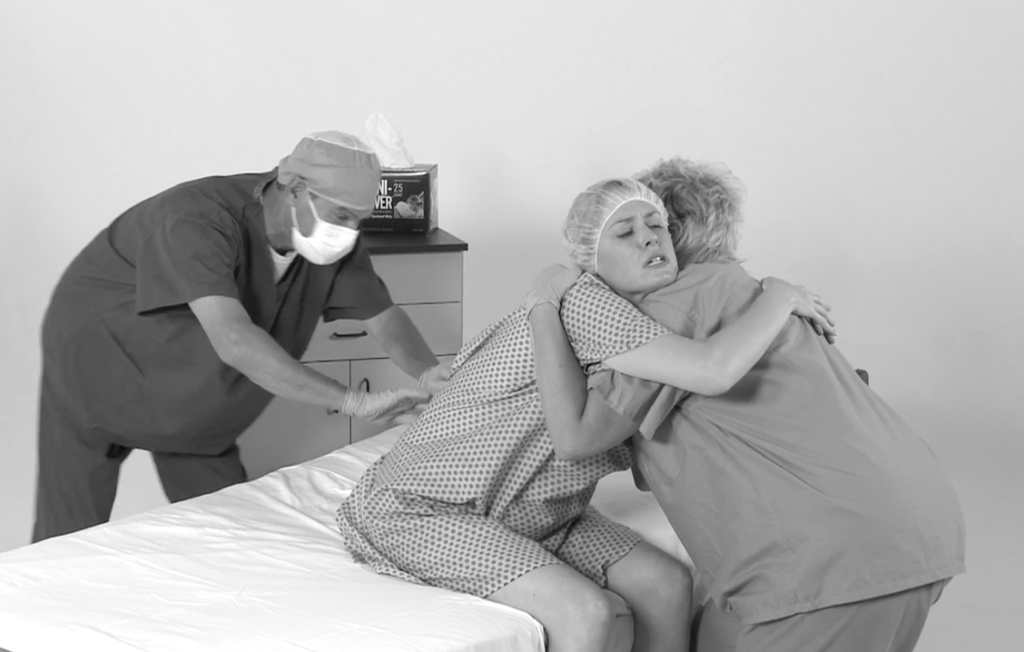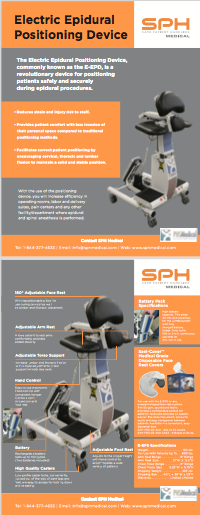
Electric Epidural Positioning Device
Anyone working with the anesthesia or pain team can relate to the difficulty of positioning patients for epidurals or spinal blocks. Lengthy static holds, awkward stacking of pillows on a bedside table that doesn’t lock, and the patient safety risk of patients moving during placement, are just a few of the challenges we face when working with patients in Labor and Deliver, General Surgery, Outpatient Surgery, and Pain Management Centers. A leading anesthesiologist helped us create the original Epidural Positioning Device with a few simple concepts in mind: Position the patient properly while improving patient and staff safety. Today the EPD is the gold standard of Epidural Positioning Devices and is the original patented EPD solution used all over the world.
Some of our leading hospital customers and health systems have standardized on the EPD include Duke University Hospital, John’s Hopkins, UCLA Medical Center, Kaiser Hospitals, University of Virginia Medical Center, VA Medical Centers, and many more.
After working with Safety and Safe Patient Handling leadership teams around the country we saw the need to develop a higher efficiency version of the original EPD with new key features that further minimize caregiver exertion, improve patient comfort, offer advanced ergonomic patient positioning with better access to all spinal areas, cervical, thoracic, and lumbar, and improves throughput for high volume departments where frequent epidural and spinal block placements occur.
Manual Patient Handling causes caregiver injuries even when “normal” patients are being handled manually. It is the cumulative nature of lifting, pushing, pulling, holding, catching, tugging, boosting, turning and transferring that causes micro tears in the vertebral discs and joints that over time lead to injury. We need to modify the way we handle patients to avoid manual handling at all costs especially when the task is predictable.
EPD Innovation
The new Electric Epidural Positioning Device or E-EPD was born from this vision. Using the same principals of positioning patients correctly to optimize spinal flexion, we put power behind the EPD. Now with the push of a button, we can raise the E-EPD to the correct height and adjust the height of the footplate, two functions that were formerly manual tasks. Now we can properly position patients up to 600lbs, providing a stable platform that promotes the ideal flexed spine or “mad cat” position with even greater access the cervical spine. The design of the E-EPD also includes a new ergonomically designed curved body that can handle patients of all shapes and sizes. The Arm Rests, Chest Pad, and Face Cushion include an easy to use locking system for simple and efficient adjustments between patients. Central locking foot pedals lock and unlock all four wheels with one push!
The E-EPD is battery powered! This means that your E-EPD is mobile and powered and can move from room to room quickly without any electrical cords or manual adjustments. In areas where patient volumes are high the E-EPD can be ready for action quickly. Simply charging the E-EPD overnight means that you’ll have battery power all day for every case.
Patient Positioning Challenges
Here are some of the challenging situations and safety risks that staff face in the Labor and Delivery unit, pre-op, OR, Outpatient Surgery, and pain clinics during epidural and spinal block placements.
- Holding patient in position – static holds – staff safety risk
- Non-locking tables – patient safety risk
- Stacking pillows on the non locking tables – patient safety risk
- Medicated patients may not be able to hold the proper position
- Trying to hold a stool in position while supporting a patient
- Patients of size may require multiple staff members to hold in position
- Patients may react unexpectedly and attempt to move
- Patients may feel dizzy or nauseous and which may result in movement
- Patients may not be able to follow instructions and try to change position
- Patients may be nervous and combative and have bitten staff members!
- When patients are difficult to position it takes more time!
Unique Benefits of the E-EPD:
- Provides a stable consistent platform that helps the Anesthesia / Pain tem standardize patient positioning
- Improves comfort and safety for patients
- Contributes to improved patient satisfaction scores
- Improves patient dignity by removing manual handling
- Reduces risk of injury to patients from improper placement
- Reduces risk of injury to caregivers by eliminating static holds
- Reduces frequency of manual handling and risk of MSD’s
- Reduces stress on caregivers back, neck, shoulder and knees by properly supporting patients
- Simple and easy to use, disinfect, and move from room to room
- Single Patient Use Covers are available for the Face Rest and Arm Rests
- The E-EPD allows caregivers to assist with other tasks
- Improves speed of set up and ideal positioning of patients
Specifications
- Weight Capacity: 600 lbs
- Dimensions: 28”Wide X 29” Depth X 49”-57″ High
- Total Weight: 110 lbs.
- Range of Arm Rests: 6” Range
- Size of Arm Rests: 16.75” X 4.5”
- Range of Chest Pad: 6” Range
- Chest pad dimensions: 6.5” x 6.5″
- Electrical: 100v, 3 Prong Plug
- Two Batteries are included
- EPD clearance: 4.5″ from floor to base, 15″- 18″ distance between wheels
- Shipping Weight: 170 lbs
- Shipping Dimensions: 36.5” x 38.5” x 50”
- Ships on a pallet – LTL Freight
SPH Medical is the authorized national distributor for Pivotal Health’s industry leading line of EPD’s.
Contact SPH Medical to request more information regarding Safe Patient Handling best practices for your facility or to request a quotation.
Visit our Our EPD Resource page for more information.


